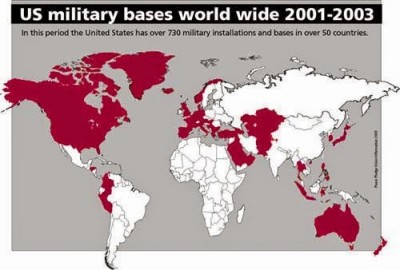The United States: A “Destroyer Of Nations”

First published by Counterpunch and Global Research in October 2016
In the aftermath of the U.S. invasion of Iraq in 2003 – an invasion which many Iraqis believe left their country in the worst condition it has been since the Mongol invasion of 1258 — there was much discussion in the media about the Bush Administration’s goal for “nation-building” in that country. Of course, if there ever were such a goal, it was quickly abandoned, and one hardly ever hears the term “nation-building” discussed as a U.S. foreign policy objective anymore.
The stark truth is that the U.S. really has no intentions of helping to build strong states in the Middle East or elsewhere. Rather, as we see time and again – e.g., in Yugoslavia, Sudan, Libya, Yemen, Syria, Somalia, Ukraine – the goal of U.S. foreign policy, whether stated or not, is increasingly and more aggressively the destruction and balkanization of independent states. However, it is important to recognize that this goal is not new.
Indeed, South Korean human rights scholar Dong Choon Kim, writing of the U.S. war in Korea (1950 – 1953) – a war which he opines was at least arguably genocidal – explains that even back then, the nation-building of Third World peoples was viewed as an act of subversion which had to be snuffed out. As he explained, “[t]he American government interpreted the aspiration for building an independent nation as an exclusive ‘communist conspiracy,’ and thus took responsibility for killing innocent people, as in the case of [the] My Lai incident in Vietnam.” [1]
Thanks to the U.S. war on Korea, Korea to this day remains a country divided in half, with no prospects for unification anytime soon. Kim explains that the Korean War
“was a bridge to connect the old type of massacres under colonialism and the new types of state terrorism and political massacre during the Cold War. . . . And the mass killings committed by US soldiers in the Korean War marked the inception of military interventions by the US in the Third World at the cost of enormous civilian deaths.”
Pyongyang totally destroyed
Similarly, the U.S. objective in Vietnam was the destruction of any prospect of an intact, independent state from being created. As Jean-Paul Sartre wrote as part of the International War Crimes Tribunal that he and Bertrand Russell chaired after the war, the U.S. gave the Vietnamese a stark choice: either accept capitulation in which the country would be severed in half, with one half run by a U.S. client, or be subjected to near total annihilation. [2] Sartre wrote that, even in the former case, in which there would be a “cutting in two of a sovereign state . . . [t]he national unit of ‘Vietnam’ would not be physically eliminated, but it would no longer exist economically, politically or culturally.”
Of course, in the latter case, Vietnam would suffer physical elimination; bombed “’back to the Stone Age’” as the U.S. threatened. As we know, the Vietnamese did not capitulate, and therefore suffered near-total destruction of their country at the hands of the United States. Meanwhile, for good measure, the U.S. simultaneously bombed both Cambodia and Laos back to the Stone Age as well.
 To understand the purpose behind such violent and destructive actions, we need look no farther than the U.S.’s own post-WWII policy statements, as well articulated by George Kennan image right) serving as the State Department’s Director of Policy Planning in 1948:
To understand the purpose behind such violent and destructive actions, we need look no farther than the U.S.’s own post-WWII policy statements, as well articulated by George Kennan image right) serving as the State Department’s Director of Policy Planning in 1948:
We must be very careful when we speak of exercising “leadership” in Asia. We are deceiving ourselves and others when we pretend to have answers to the problems, which agitate many of these Asiatic peoples. Furthermore, we have about 50% of the world’s wealth but only 6.3 of its population. This disparity is particularly great as between ourselves and the peoples of Asia. In this situation, we cannot fail to be the object of envy and resentment. Our real task in the coming period is to devise a pattern of relationships, which will permit us to maintain this position of disparity without positive detriment to our national security. To do so we will have to dispense with all sentimentality and daydreaming; and our attention will have to be concentrated everywhere on our immediate national objectives.
We need not deceive ourselves that we can afford today the luxury of altruism and world benefaction…In the face of this situation we would be better off to dispense now with a number of the concepts which have underlined our thinking with regard to the Far East. We should dispense with the aspiration to ‘be liked’ or to be regarded as the repository of a high-minded international altruism. We should stop putting ourselves in the position of being our brothers’ keeper and refrain from offering moral and ideological advice. We should cease to talk about vague — and for the Far East — unreal objectives such as human rights, the raising of the living standards, and democratization. The day is not far off when we are going to have to deal in straight power concepts. The less we are hampered by idealistic slogans, the better.
While it would have been impossible for the U.S. to continue to monopolize a full half of the world’s wealth after Europe, Japan, China and the USSR inevitably got up upon their feet after WWII, the U.S. has nonetheless done an amazing job of controlling an unjustifiable and disproportionate amount of the world’s resources.
Thus, currently, the U.S. has about 5% of the world’s population, and consumes about 25% of its resources. An article in Scientific American, citing the Sierra Club’s Dave Tilford, explains that,
“‘[w]ith less than 5 percent of world population, the U.S. uses one-third of the world’s paper, a quarter of the world’s oil, 23 percent of the coal, 27 percent of the aluminum, and 19 percent of the copper . . . . Our per capita use of energy, metals, minerals, forest products, fish, grains, meat, and even fresh water dwarfs that of people living in the developing world.’” [3]
The only way the U.S. has been able to achieve this impressive, though morally reprehensible, feat has been to undermine, many times fatally, the ability of independent states to exist, defend themselves and to protect their own resources from foreign plunder. This is why the U.S. has teamed up with the world’s most deplorable forces in destroying independent states around the globe.
Just to name a few examples, since 1996, the U.S. has supported Rwandan and Ugandan forces in invading the Democratic Republic of Congo, making that country ungovernable and plundering its incredible natural resources. The fact that around 6 million innocents have been murdered in the process is of no matter, and certainly not to the main stream press which rarely mentions the DRC. In Colombia, the U.S. has backed a repressive military and right-wing paramilitaries for decades in destabilizing whole swaths of the Colombian countryside, and in assisting multinational corporations, and especially extractive industries, in displacing around 7 million people from their homes and land, all in order to exploit Colombia’s vast oil, coal and gold reserves. Again, this receives barely a word in the mainstream press.
Of course, in the Middle East, Northern Africa and Afghanistan, the U.S. has been teaming up with Saudi Arabia and radical Islamist forces – forces the U.S. itself has dubbed “terrorist” – in undermining and destroying secular states.
As far back as the 1970’s, the U.S. began supporting the mujahidin in attacking the secular, Marxist state of Afghanistan in order to destroy that state and also to fatally weaken the Soviet state by, in the words of Zbigniew Brzezinski, “drawing the Russians into the Afghan trap . . . [and] giving to the USSR its Vietnam war.” Afghanistan may never recover from the devastation wrought by that fateful decision of the U.S. and its subsequent intervention which is now into its 15th year and counting. As we know full well, the USSR never recovered either, and the U.S. is trying mightily to prevent post-Soviet Russia from becoming a strong rival state again.
Meanwhile, in Libya, the U.S. again partnered with jihadists in 2011 in overthrowing and indeed smashing a state which used its oil wealth to guarantee the best living standards of any country in Africa while assisting independence struggles around the world. In this way, Libya, which under Qaddafi also happened to be one of the staunchest enemies of Al-Qaeda in the world, presented a double threat to U.S. foreign policy aims. Post-intervention Libya is now a failed state with little prospects of being able to secure its oil wealth for its own people again, much less for any other peoples in the Third World. And so, mission accomplished!
In addition, as we learned from Seymour Hersh back in 2007, the U.S. began at that time to try to weaken Iran and Syria by supporting Sunni extremist groups to subvert those countries. [4] As Hersh explained:
To undermine Iran, which is predominantly Shiite, the Bush Administration has decided, in effect, to reconfigure its priorities in the Middle East. In Lebanon, the Administration has cooperated with Saudi Arabia’s government, which is Sunni, in clandestine operations that are intended to weaken Hezbollah, the Shiite organization that is backed by Iran. The U.S. has also taken part in clandestine operations aimed at Iran and its ally Syria. A by-product of these activities has been the bolstering of Sunni extremist groups that espouse a militant vision of Islam and are hostile to America and sympathetic to Al Qaeda.One contradictory aspect of the new strategy is that, in Iraq, most of the insurgent violence directed at the American military has come from Sunni forces, and not from Shiites.
The U.S. continues to intervene in Syria in a way which prevents the Syrian state from achieving a decisive victory against the various militant groups it is fighting – some of which the U.S. itself admits are terrorists – while at the same time targeting some of these same militant groups themselves, thereby preventing either side of the conflict from coming out on top. Indeed, as we have learned, the CIA and the Pentagon have even been backing opposing militant groups that are fighting each other! [5] The result is a drawn-out war which threatens to leave Syria in chaos and ruins for the foreseeable future.
This would seem to be an insane course of action for the U.S. to take, and indeed it is, but there is method to the madness. The U.S. appears to be intentionally spreading chaos throughout strategic portions of the world; leaving virtually no independent state standing to protect their resources, especially oil, from Western exploitation. And, this goal is being achieved with resounding success, while also achieving the subsidiary goal of enriching the behemoth industrial-military complex.
Jose Marti once said, “there are two kinds of people in the world: those who love and create, and those who hate and destroy.” There is no doubt that the U.S. has proven itself to be of the latter kind; indeed, the very nature of U.S. foreign policy is destruction. Given this, it is at best foolish and naïve for people of any political stripe, but particularly self-defined leftists, to put any stock in the notion that the U.S. is acting in the defense of human rights, democracy or any such lofty goals in intervening militarily abroad.
There is only one proper goal, then, of people of good will – to oppose U.S. military intervention with every fiber of our being.
Notes.
[3] https://www.scientificamerican.com/article/american-consumption-habits/
[4] http://www.newyorker.com/magazine/2007/03/05/the-redirection
[5] http://www.latimes.com/world/middleeast/la-fg-cia-pentagon-isis-20160327-story.html
Daniel Kovalik teaches International Human Rights at the University of Pittsburgh School of Law.


